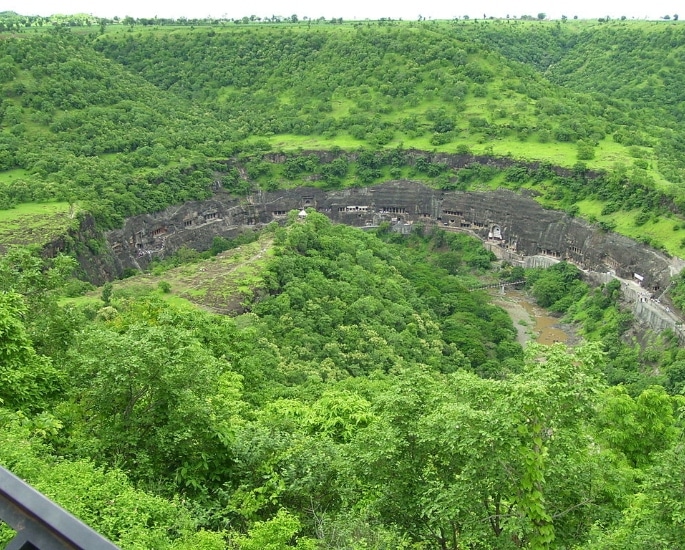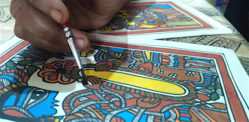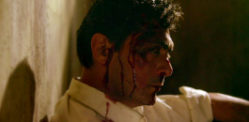"the magnificent caves with the exquisite paintings truly transcend you."
The Ajanta Caves are an amazing combination of architecture, paintings and sculptures.
The thirty caves are famous all over the world, highlighting the masterful planning and execution of the monuments.
The Ajanta Caves have become the most eye-catchy tourist hot spot in Aurangabad, Maharashtra.
Tourists regularly visit the caves, which continuously preserve ancient Indian art and the memories of the builders who made them.
Within the defile, there are also a number of waterfalls. They are audible from an outer area of the caves when the river elevates.
Ajanta Caves got recognition as a UNESCO (United Nations Educational, Scientific and Cultural Organisation) World Heritage Site in 1983.
UNESCO approves some of the oldest cultural heritage sites around the world. Similarly, the caves have a feel of ancient Indian culture and tradition.
Expressing views on Holiday IQ, a travel and tour site, a visitor states:
“It indeed is a lifetime experience, the magnificent caves with the exquisite paintings truly transcend you to an ancient era where you can feel artistic and spiritual resources everywhere.”
We delve further into the artistic importance of the Ajanta Caves, bringing to light its soul and spirit.
Architecture

Interestingly the Ajanta Caves are made of basaltic rock cliffs, linking to the Deccan Traps.
The Deccan Traps are naturally formed by an excessive volcanic disruption at the end of the Cretaceous period.
In other words, natural calamities have helped to give shape to these wonderful caves. In the creation of the caves, rocks which varied in quality were placed horizontally.
Placing variations within the rock layers needed artistic mastery to amend making techniques and plans.
Ajanta Caves are monuments, which have been made into shapes of steep rock-cut horseshoes.
The caves are located in Aurangabad, Maharashtra.
The grotto monasteries formed the Ajanta Caves, which were carved between the 2nd century BC to the 6th century AD.
Moreover, rock carven art is built according to the different traditions of meditating halls.
Certainly, brilliant detailing of the caves are amongst the greatest examples of this ancient Indian cave art.
These caves are in the Deccan Plateau, specifically in the U-shaped defile of the river Waghur housing a rocky northern wall.
Paintings

Ajanta Caves are adorned with wonderful paintings of the Jataka tales, which interestingly relate to the voluminous body of Indian literature.
Paintings on the cave walls reflect stories of problems and happy endings. The apologue shows stunning ancient, cultural and moral folklores.
Several elemenrs of Ajanta murals, especially in caves ten and eleven are very unique.
Ajanta is famous for its masterful line of paintings with natural pigments and harmony within all the components.
Most importantly, there is a perfect symmetry of vibrant and soft hues in the artefacts, which make all of them more magnificent.
The paintings represent segments of love, sensuality and imperturbable sages.
The wall paintings depict a multitude of artists who have made these striking displays with a diverse style and quality. The ceiling of these grottos invariably consists of geometrical and floral patterns.
The brush technique and method of execution illustrate the unquestionable mastery of the craftsmen. Great pictorial knowledge of the painter has made the Ajanta walls known across the world.
The Ajanta Caves wall art aims to transmit a rhythmic balance, portraying the harmony of society. As in Indian society, the smallest desire and gesture has a special place.
The key colours used in the murals are red ochre, lamp black, white, brown ochre, yellow ochre and lapis lazuli. The hues came from Persia, northern India and central Asia.
Characters are drawn with striking and multi colours, which are not repeated.
A tourist complimenting the paintings on the travel site Trip Advisor writes:
“In one of the painting you can see the man wearing colourful socks and ladies wearing designer jewellery that can outdate the recent fashion of modern world.”
Sculptures

Sculptors have put their best efforts into carving up the grottoes, making pillars, roofs, and idols. Sculptures and paintings were made parallel to the carving work.
Ajanta statues are also made with carving rock from the caves, which are beyond one’s imagination.
As per the planning of the architects, the statues in the caves are in standing and sitting positions. This is because all the caves have needed different types of carving as per the space and placement of natural rocks.
Almost every cave has wondrous sculptures but cave nineteen is famous for its skilled statue work.
It has sculptures showing scenes about ‘mother and child’ care, as well as many more with similar themes.
Some caves highlight the fact that builders have had to put much more effort into the sculptures in comparison to the paintings that are there.
Sculptures in some grottoes are solely holding the attention of the visitors.
The caves have an amazing blend of human and animal sculptures, particularly the elephant.
From an early age, the elephant has been regardedd as a royal animal in India. In cave twenty-six sculptures are said to be made with stones, with more intricate detailing.
Behind the centre of the rare wall to the caves, is a big shrine room, which contains large sculptures.
The statues in Ajanta are huge and are made according to the size of the caves. Carved sculptures in Ajanta showcase the skill and hard work of the makers.
Importance

The caves are very significant, particularly from an archaeological point of view.
Ajanta has also preserved a distinctive specimen of ancient Indian paintings and art across the thirty cave.
A narration of wonderful stories through the paintings and the details on them have put the Ajanta Caves on the world map.
Moreover, a colourful wall play on the rock caves are the focal points of Indian culture and morals.
The importance of architecture lays in the wide features, which historically promote vitality. Intricacy in the roofs, pillars, huge cavern, stupas and gathering halls have a distinct touch of art.
The Ajanta Cave network has built-in two dominant types of Chaityas and Viharas.
Caves with stupas are Chaityas for meditating purposes. Whilst Vihara caves are centres for study and education purposes.
The creative expression of freedom with stunning colours are also significantly important.
The caves are not natural. They are rock-cut manmade caves, which is another proof of strong Indian artistic knowledge and awareness.
Most noteworthy, every stone has something to say about its artistic importance. The reflection of art in these caves points to the glory of ancient Indian civilisation
Above all, according to the caves guidelines using flash while taking a picture is prohibited. This is because flash can dull the natural rock art.
The best time to visit the caves is during the winter season. Summer is not a good time with the weather in Maharashtra being very warm then.
Ajanta Caves are a must-visit when travelling to India. It is only then that you can appreciate the artistic importance of this world heritage site,





























































